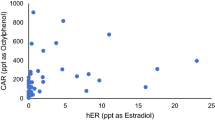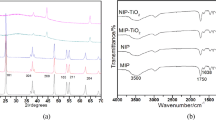Abstract
In this study, the effects of environmental factors, including humic acid (HA), pH, ionic strength, and the coexistence of competing estrogenic compounds, on the adsorption of four typical estrogenic compounds, estrone (E1), 17β-estradiol (E2), 17α-ethinylestradiol (EE2), and bisphenol A (BPA), were studied by molecularly imprinted polymer (MIP). The adsorption capacities of MIP for E2 were 116.3, 118.5, 127.0, and 109.0 µmol/g at HA concentrations of 0, 5, 15, and 20 mg/L in total organic carbon, respectively, while the corresponding adsorption capacities of nontemplate imprinted polymer (NIP) for E2 were 98.1, 109.4, 113.8, and 98.0 µmol/g. This implied that no significant trend could be found with the increasing HA concentrations. Furthermore, the selective adsorption capacity, represented by the difference in adsorption capacities between MIP and NIP, was not affected significantly. Similar observations were noted for E1, EE2, and BPA in the presence of HA. Ionic strength did not exert a considerable influence on the adsorption capacities of MIP and NIP for E1, E2, and BPA. However, at 0 mM of NaCl, EE2 adsorption capacities of MIP and NIP were 124.7 and 111.7 µmol/g, respectively, while the corresponding adsorption capacities were 144.7 and 138.2 µmol/g at 10 mM of NaCl due to the increased hydrophobic interactions. Nevertheless, the selective adsorption capacity was not significantly affected by the range of ionic strength tested in this study. The study demonstrated that there was no significant effect of pH on the adsorption capacity of both MIP and NIP from pH 3.1 to 9 and that no considerable effect of pH on selective adsorption capacity of MIP could be established. However, the adsorption capacities of MIP and NIP for E2 at pH 9 were 95.1 and 82.9 µmol/g, while at pH 11, the adsorption capacities were 12.1 and 5.9 µmol/g correspondingly. This means that adsorption capacity and selective adsorption capacity were influenced significantly due to the ionization of target compounds. A similar trend was observed for E1, EE2, and BPA. The study on the effect of the coexistence of competing estrogenic compounds demonstrated that selective adsorption capacities of MIP can be influenced. Differences between MIP and NIP for E1, E1, EE2, and BPA under competing conditions were 8.8, 6.8, 10.2, and 4.2 µmol/g, respectively, while the corresponding differences were 12.6, 18.2, 13.0, and 9.8 µmol/g, respectively, when adsorbed individually.




Similar content being viewed by others
References
Bartsch, R. A., & Maeda, M. (1998). Molecular and ionic recognition with imprinted polymers. Washington: American Chemical Society.
Bravo, J. C., Fernandez, P., & Durand, J. S. (2005). Flow injection fluorimetric determination of b-estradiol using a molecularly imprinted polymer. Analyst, 130, 1404–1409.
Coleman, H. M., Rouledge, E. J., & Sumpter, J. P. (2004). Rapid loss of estrogenicity of steroid estrogens by UVA photolysis and photocatalysis over an immobilised titanium dioxide catalyst. Water Research, 38(14–15), 3233–3240.
Fukuhara, T., Iwasaki, S., Kawashima, M., Shinohara, O., & Abe, I. (2006). Adsorbability of estrone and 17β-estradiol in water onto activated carbon. Water Research, 40(2), 241–248.
Hemming, J. M., Allen, H. J., & Thuesen, K. A. (2004). Temporal and spatial variability in the estrogenicity of a municipal wastewater effluent. Ecotoxicology and Environmental Safety, 57, 303–310.
Jason, G., Birkett, W., & Lester, J. N. (2003). Endocrine disruptors in wastewater and sludge treatment process. Boca Raton: Lewis.
Joss, A., Andersen, H., & Ternes, T. (2004). Removal of estrogens in municipal wastewater treatment under aerobic and anaerobic conditions: Consequences for plant optimization. Environmental Science and Technology, 38, 3047–3055.
Kuramitz, H., Natsui, J., & Sugawara, K. (2002). Electrochemical evaluation of the interaction between endocrine disrupter chemicals and estrogen receptor using 17β-estradiol labeled with daunomycin. Analytical Chemistry, 74(3), 533–538.
Le Noir, M., Guieysse, B., & Mattiasson, B. (2006). Removal of trace contaminants using molecularly imprinted polymers. Water Science and Technology, 53(11), 205–212.
Le Noir, M., Lepeuple, A. S., Guieyssea, B., & Mattiasson, B. (2007a). Selective removal of 17β-estradiol at trace concentration using a molecularly imprinted polymer. Water Research, 41(12), 2825–2831.
Le Noir, M., Plieva, F., Hey, T., Guieyssea, B., & Mattiasson, B. (2007b). Macroporous molecularly imprinted polymer/cryogel composite systems for the removal of endocrine disrupting trace contaminants. Journal of Chromatography, 1154(1–2), 158–164.
Lin, Y., Shi, Y., Jiang, M., Jin, Y., Peng, Y., Lu, B., et al. (2008). Removal of phenolic estrogen pollutants from different sources of water using molecularly imprinted polymeric microspheres. Environmental Pollution, 153(2), 483–491.
Meng, Z., Chen, W., & Mulchandani, A. (2005). Removal of estrogenic pollutants from contaminated water using molecular imprinted polymers. Environmental Science and Technology, 39(22), 8958–8962.
Nghiem, L. D., & Schäfer, A. I. (2006). Critical risk points of nanofiltration and reverse osmosis processes in water recycling applications. Desalination, 187, 303–312.
Nghiem, L. D., Manis, A., Soldenhoff, K., & Schäfer, A. I. (2004). Estrogenic hormone removal from wastewater using NF/RO membranes. Journal of Membrane Science, 242, 37–45.
Nishiyama, S., Goto, A., & Saito, K. (2002). Concentration of 17β-estradiol using an immunoaffinity porous hollow-fiber membrane. Analytical Chemistry, 74(19), 4933–4936.
Ohko, Y., Iuchi, K., Niwa, C., Tatsuma, T., Nakashima, T., Iguchi, T., et al. (2002). 17β-Estradiol degradation by TiO2 photocatalysis as a means of reducing estrogenic activity. Environmental Science and Technology, 36, 4175–4181.
Servos, M. R., Bennie, D. T., & Burnison, B. K. (2005). Distribution of estrogens, 17β-estradiol and estrone, in Canadian municipal wastewater treatment plants. Science of the Total Environment, 336, 155–170.
Tanizaki, T., Kadokami, K., & Shinohara, R. (2002). Catalytic photodegradation of endocrine disrupting chemicals using titanium dioxide photosemiconductor thin films. Bulletin of Environmental Contamination and Toxicology, 68(5), 732–739.
Ternes, T. A., Stumpf, M., & Mueller, J. (1999a). Behavior and occurrence of estrogens in municipal sewage treatment plants—I. Investigations in Germany, Canada, and Brazil. Science of the Total Environment, 225, 81–90.
Ternes, T. A., Kreckel, P., & Mueller, J. (1999b). Behavior and occurrence of estrogens in municipal sewage treatment plants—II. Aerobic batch experiments with activated sludge. Science of the Total Environment, 225, 91–99.
Urmenyi, A. M., Poot, A. A., Wessling, M., & Mulder, M. H. V. (2005). Affinity membranes for hormone removal from aqueous solutions. Journal of Membrane Science, 259(1–2), 91–102.
Ying, G. G., Kookana, R. S., & Dillon, P. (2003). Sorption and degradation of selected five endocrine disrupting chemicals in aquifer material. Water Research, 37(15), 3785–3791.
Yu, Q., Deng, S., & Yu, G. (2008). Selective removal of perfluorooctane sulfonate from aqueous solution using chitosan-based molecularly imprinted polymer adsorbents. Water Research, 42(12), 3089–3097.
Zhang, Z., & Hu, J. (2008). Selective removal of estrogenic compounds by molecular imprinted polymer (MIP). Water Research, 42(15), 4101–4108.
Zhang, Y., & Zhou, J. L. (2005). Removal of estrone and 17β-estradiol from water by adsorption. Water Research, 39(16), 3991–4003.
Author information
Authors and Affiliations
Corresponding author
Rights and permissions
About this article
Cite this article
Zhang, Z., Hu, J. Effect of Environmental Factors on Estrogenic Compounds Adsorption by MIP. Water Air Soil Pollut 210, 255–264 (2010). https://doi.org/10.1007/s11270-009-0247-x
Received:
Accepted:
Published:
Issue Date:
DOI: https://doi.org/10.1007/s11270-009-0247-x




